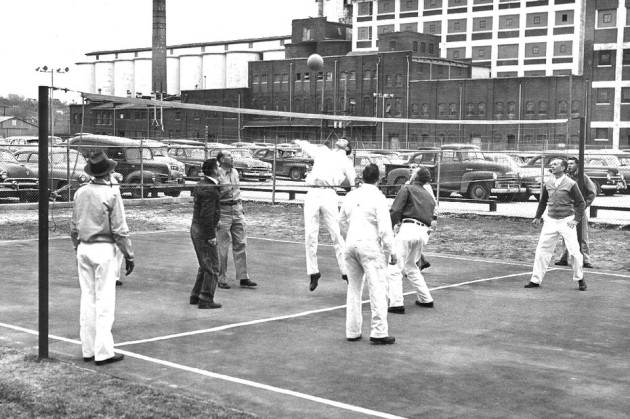
Volleyball
Today there are more than 46 million Americans who play volleyball.
There are 800 million players worldwide who play Volleyball at least once a week.
1895, William G. Morgan, an instructor at the Young Men’s Christian Association (YMCA) in Holyoke, Mass., decided to blend elements of basketball, baseball, tennis, and handball to create a game for his classes of businessmen which would demand less physical contact than basketball. He created the game of Volleyball (at that time called mintonette). Morgan borrowed the net from tennis, and raised it 6 feet 6 inches above the floor, just above the average man’s head.
During a demonstration game, someone remarked to Morgan that the players seemed to be volleying the ball back and forth over the net, and perhaps “volleyball” would be a more descriptive name for the sport.
1896, July 7th – at Springfield College the first game of “volleyball” was played.
1900, a special ball was designed for the sport.
1900 – YMCA spread volleyball to Canada, the Orient, and the Southern Hemisphere.
1905 – YMCA spread volleyball to Cuba
1907 Volleyball was presented at the Playground of America convention as one of the most popular sports
1909 – YMCA spread volleyball to Puerto Rico
1912 – YMCA spread volleyball to Uruguay
1913 – Volleyball competition held in Far Eastern Games
1916, in the Philippines, an offensive style of passing the ball in a high trajectory to be struck by another player (the set and spike) were introduced. The Filipinos developed the “bomba” or kill, and called the hitter a “bomberino”.
1916 – The NCAA was invited by the YMCA to aid in editing the rules and in promoting the sport. Volleyball was added to school and college physical education and intramural programs.
1917 – YMCA spread volleyball to Brazil
1917, the game was changed from 21 to 15 points.
1919 American Expeditionary Forces distributed 16,000 volleyballs to it’s troops and allies. This provided a stimulus for the growth of volleyball in foreign lands.
1920, three hits per side and back row attack rules were instituted.
1922, the first YMCA national championships were held in Brooklyn, NY. 27 teams from 11 states were represented.
1928, it became clear that tournaments and rules were needed, the United States Volleyball Association (USVBA, now USA Volleyball) was formed. The first U.S. Open was staged, as the field was open to non-YMCA squads.
1930‘s Recreational sports programs became an important part of American life
1930, the first two-man beach game was played.
1934, the approval and recognition of national volleyball referees.
1937, at the AAU convention in Boston, action was taken to recognize the U.S. Volleyball Association as the official national governing body in the U.S.
Late 1940s Forearm pass introduced to the game (as a desperation play). Most balls were played with overhand pass.
1946 A study of recreation in the United States showed that volleyball ranked fifth among team sports being promoted and organized
1947, the Federation Internationale De Volley-Ball (FIVB) was founded in Paris.
1948, the first two-man beach tournament was held.
1949, the first World Championships were held in Prague, Czechoslovakia.
1949 USVBA added a collegiate division, for competitive college teams. For the first ten years collegiate competition was sparse. Teams formed only through the efforts of interested students and instructors. Many teams dissolved when the interested individuals left the college. Competitive teams were scattered, with no collegiate governing bodies providing leadership in the sport.
1951 – Volleyball was played by over 50 million people each year in over 60 countries
1955 – Pan American Games included volleyball
1957 – The International Olympic Committee (IOC) designated volleyball as an Olympic team sport, to be included in the 1964 Olympic Games.
1959 – International University Sports Federation (FISU) held the first University Games in Turin, Italy. Volleyball was one of the eight competitions held.
1960 Seven midwestern institutions formed the Midwest Intercollegiate Volleyball Association (MIVA)
1964 Southern California Intercollegiate Volleyball Association (SCVIA) was formed in California
1960‘s new techniques added to the game included – the soft spike (dink), forearm pass (bump), blocking across the net, and defensive diving and rolling.
In 1964, Volleyball was introduced to the Olympic Games in Tokyo.
The Japanese volleyball used in the 1964 Olympics, consisted of a rubber carcass with leather panelling. A similarly constructed ball is used in most modern competition.
In 1965, the California Beach Volleyball Association (CBVA) was formed.
1968 National Association of Intercollegiate Athletics (NAIA) made volleyball their fifteenth competitive sport.
1969 The Executive Committee of the NCAA proposed addition of volleyball to its program.
1974, the World Championships in Mexico were telecast in Japan.
1975, the US National Women’s team began a year-round training regime in Pasadena, Texas (moved to Colorado Springs in 1979, Coto de Caza and Fountain Valley, CA in 1980, and San Diego, CA in 1985).
1977, the US National Men’s team began a year-round training regime in Dayton, Ohio (moved to San Diego, CA in 1981).
1983, the Association of Volleyball Professionals (AVP) was formed.
1984, the US won their first medals at the Olympics in Los Angeles. The Men won the Gold, and the Women the Silver.
1986, the Women’s Professional Volleyball Association (WPVA) was formed.
1987, the FIVB added a Beach Volleyball World Championship Series.
1988, the US Men repeated the Gold in the Olympics in Korea.
1989, the FIVB Sports Aid Program was created.
1990, the World League was created.
1992, the Four Person Pro Beach League was started in the United States.
1994, Volleyball World Wide, the first internet site on the sport of volleyball, was created.
1995, the sport of Volleyball was 100 years old!
1996, 2-person beach volleyball was added to the Olympics
Read more articles from our Did You Know? section.
Check out our Fitness section, every Saturday a new story! Tomorrow read about Volleyball Leg Workout.